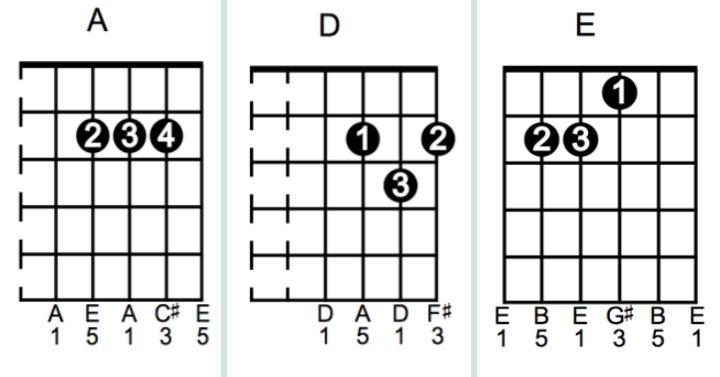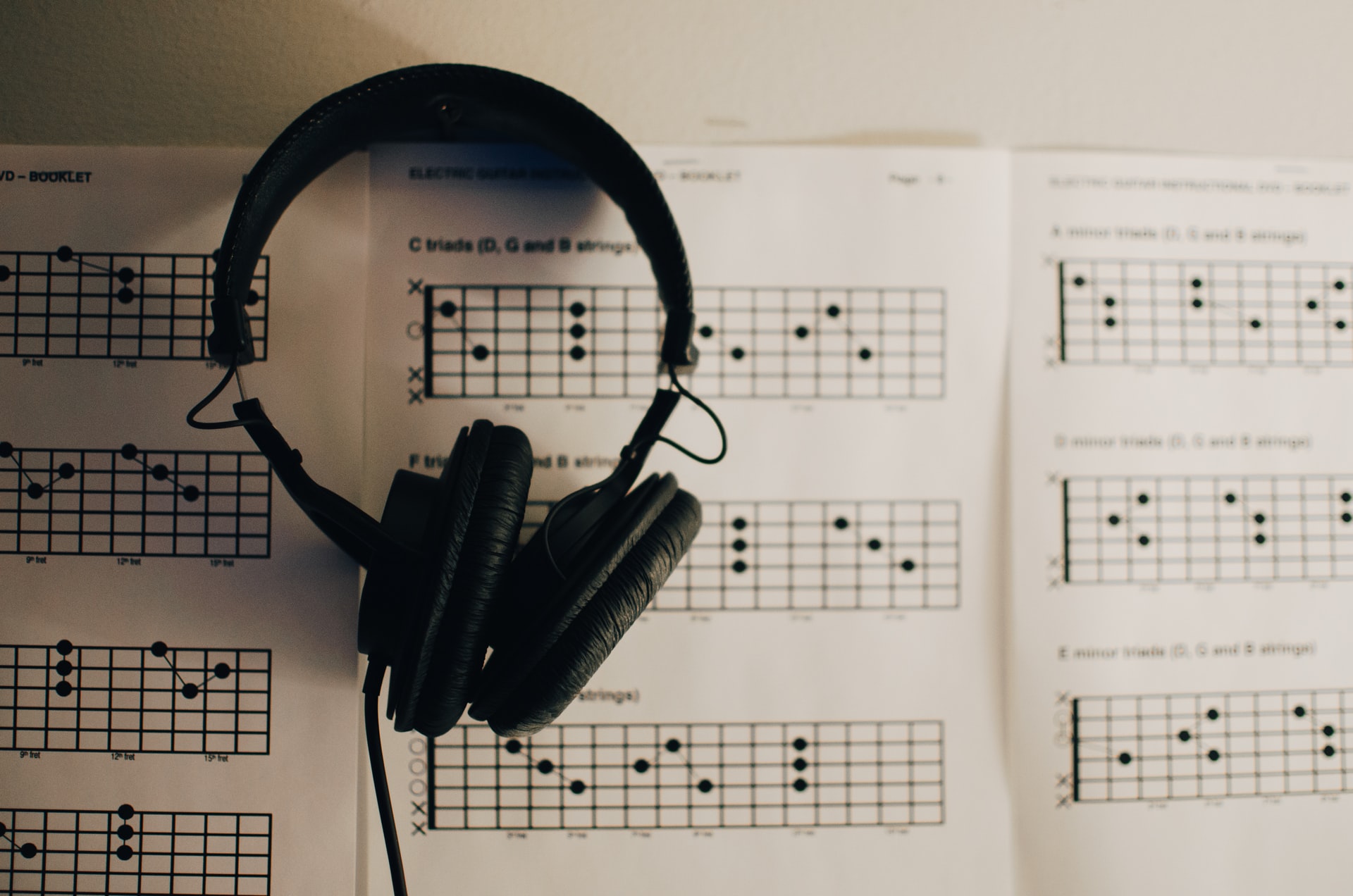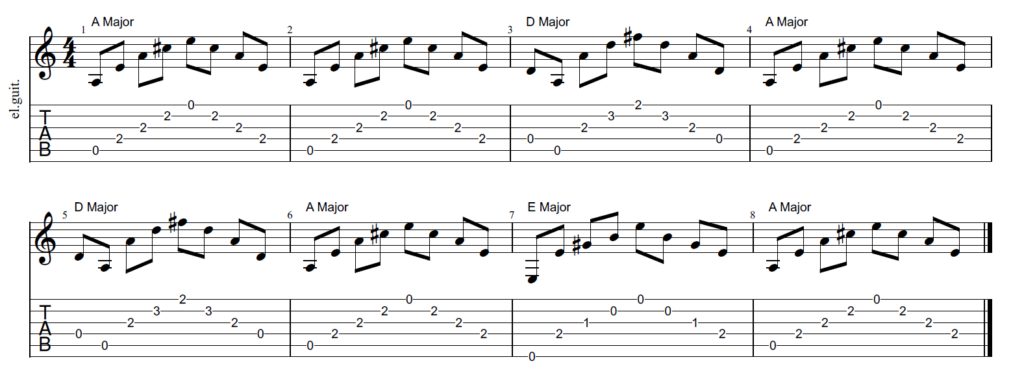“You Are My Sunshine” is a very popular American song that was recorded and released by Jimmie Davis and Charles Mitchell at the beginning of 1940. There are literally hundreds of different versions that came out after that, so it is extremely likely that you have heard it being interpreted by more than one artist. For this guide, we will take the version by Johnny Cash as an example. It is an excellent tune for you to learn, whether you are a beginner guitarist or an experienced musician since its easy harmony and structure allow you to be more creative with how you approach the You Are My Sunshine guitar chords.
In short, you only need to be acquainted with a few easy chords that you have probably already learned on the guitar: A Major, D Major, and E Major.
This guide will teach you how to play these chords on the guitar, and how to approach them in a few different ways so that you can play this song more musically. It will also cover basic harmony concepts that should help you understand this song better, as well as other songs that feature the same kind of chord progression.
Song Overview – Time Signature and Harmony
Time Signature
Fortunately for you, there is nothing challenging about the time signature of the song You Are My Sunshine. It is in 4/4 time, also known as “common time” since it is arguably the most used time signature in general.
4/4 time means that each bar/measure has 4 beats, and each quarter note is worth one beat.
Harmony – What are the chords in You Are My Sunshine?
This song does not have a complex harmony by any means whatsoever, so this is going to be light material.
The version of this song recorded by Johnny Cash is in the key of A Major, which means that A Major is also the tonic chord, also represented by “I” in Roman numerals. The other chords in the song relate to the tonic/root and have different roles depending on the interval between them.
This song only has 3 chords: A Major, D Major, and E Major.
These are all that you must know how to play in order to get through the song’s verse and chorus sections.
In case you need a quick reminder of how to play these chords using their open positions on the guitar, you can check the diagrams below.

If you haven’t mastered barre chords yet, then this song is a great option for you to learn, since you will have a much easier time playing every section without having to worry about getting a clean sound from chords that feature a barre shape.
You can also use lots of other chord voicings, such as inversion of these 3 chords to add more variety to your playing. You will be following the same harmony, but accentuating different notes by choosing to play chords in different positions.
Here are a few quick tips that you should also take into account while playing the chords of You Are My Sunshine:
- When you play the A Major chord, you should mute the 6th string (E) and ensure that the 5th string (A) is ringing clearly, so that you have a well-defined chord. If you are playing with an alternating bass, you should alternate between the 5th and the 6th string as you play.
- When you play the D Major chord, you should apply the same logic as with A Major, except with the 4th and 5th strings (D and A). You should never play the open 6th string while strumming a D Major since it will muddy up the chord’s sound.
You Are My Sunshine Chord Progression Analysis

Now, let’s go deeper into this song’s harmony to figure out how these chords relate to each other, and what effect this has on how to song feels.
We do this by analyzing the distance between chords in relation to the root, which in this case is A Major. Being able to figure this out is an amazing tool to play, compose and improvise better music.
Since the song is in A Major, we must take the A Major scale as our foundation. It uses the following notes:
- A (Root/Tonic)
- B (Major Second)
- C# (Major Third)
- D (Perfect Fourth)
- E (Perfect Fifth)
- F# (Major Sixth)
- G# (Major Seventh)
Since this song uses the chords A, D, and E, we can also represent them by Roman numerals:
- I chord – A Major (Tonic)
- IV chord – D Major (Subdominant)
- V chord – E Major (Dominant)
This means that we have a “I, IV, V” progression in our hands. This one is in the key of A, but you can use the Roman numerals system to represent the same chord progression in any other key. This is what makes this concept so useful.
You could easily teach an experienced musician the whole song by calling out the numbers referring to the chord degrees, and they would work regardless of the key you were playing in.
For example, in the key of E Major, a I, IV, V chord progression would have the chords E Major, A Major and B Major.
The terms “tonic”, “subdominant” and “dominant” refer to the harmonic functions that each chord has in this key.
The tonic establishes a sense of “home”. The subdominant chords make you feel like you’re moving away from that initial sensation, and the dominant chords are meant to create tension that is later resolved when coming back to the tonic.
This is how many songs that you have listened to essentially work, and knowing the role that each chord or chord degree has in a key center allows you to understand music at a much deeper level.
How to play You Are My Sunshine – Guitar Chords, Strumming Patterns, and Other Approaches
If you have already memorized the chords to a song and know how to play them on the guitar, you’re about halfway. Now, you need to know what kind of technique you will use, what rhythmic patterns, among other things.
You can take advantage of having a simple chord progression to focus a bit more on how you can make it interesting. This can come from using good chord voicings, intricate rhythmic patterns, and more.
This section is dedicated to giving you some ideas on how you could play the chords of the song You Are My Sunshine. You can use these suggestions to try to come up with an original pattern of yours.
Obviously, you can use these patterns for other chord progressions, you might just need to slightly adapt the fingering to one or two chords.
Pattern Number 1
The first pattern is going to be as simple as possible, perfect for you to concentrate on the chord progression itself, ideally while you are memorizing it.
It consists of playing each chord twice in every measure, enough to keep the harmonic rhythm going, and not too much, so that we do not overcomplicate things.
For this one, you can use either a pick or your fingers, there really isn’t one that is more correct than the other. Ultimately, it comes down to what you think is more comfortable for you, and what sounds best in the context that you are playing this song in.
A fingerstyle technique will sound a bit warmer and tamer, and strumming the chords with a pick will have a stronger attack, a sharper sound and more volume.
Check out the tab below to see exactly how you can apply this pattern to the chord progression of You Are My Sunshine.

You can use this pattern while you are getting familiar with the song’s structure, and you can quickly start to improve upon it by adding small details that can make the chord progression a little bit more interesting.
This could include some more rhythmic elements, percussive strums, chord embellishments, and much more.
Pattern Number 2
Our second pattern is meant to be played using a fingerstyle technique since it consists of arpeggiating the chords of the song.
It is still possible to play this with a pick, but you will have a much harder time trying to get the strings sounding balanced, and you will end up using more energy than needed since your wrist is going to be moving up and down more.
If you use your fingers, you will have a much larger degree of control over your movements, and consequently, the song is going to sound much smoother.
The guitar tab below illustrates this pattern with the chord progression of the song You Are My Sunshine.

This kind of approach works very well with other songs too, regardless of their chord progression. If you deconstruct each chord and arpeggiate them like this, your guitar can be a valuable asset in any studio recording.
Once again, you can also improve upon this pattern by adding things such as embellishments to the chords, but you must always pay attention to where you are located in each measure, otherwise, you might get lost in the song, and there’s no worse feeling than that when you’re playing with other people.
Additional Songs Featuring a Similar Harmony to You Are My Sunshine
As we have already discussed, songs that have a “I, IV, V” chord progression are very common in music, which is why you can often play a medley containing a dozen songs without ever changing the chords you are playing.
Below, you will find a few examples of songs that also feature the same “I, IV, V” chord progression that we have seen with You Are My Sunshine:
- The Clash – Should I Stay Or Should I Go
- Chuck Berry – Johnny B. Goode
- The Rolling Stones – Not Fade Away
- Creedence Clearwater Revival – Bad Moon Rising
- Aretha Franklin – Spanish Harlem
- Elvis Presley – I Really Don’t Want to Know
- Nickelback – How You Remind Me
- One Direction – What Makes You Beautiful
- Rod Stewart – Rhythm Of My Heart
- Bruce Springsteen – Glory Days
You can use these songs and countless more to look for inspiration to create your own songs using the same chord progression, or a variation of it!
FAQ – Frequently Asked Questions About Your Are My Sunshine Guitar Chords
Question: In what key is the song You Are My Sunshine by Johnny Cash?
Answer: The version of You Are My Sunshine recorded by Johnny Cash is played in the key of A Major. Other artists might play it a bit higher or lower to better suit their voice.
Question: What is You Are My Sunshine’s chord progression?
Answer: The chord progression featured in You Are My Sunshine is a simple, popular and effective example of a “I, IV, V” progression.
In the case of Johnny Cash’s version, since it is in A Major, this means that the chords are A Major, D Major, and E Major.
Question: Who are some of the artists that have recorded a version of You Are My Sunshine?
Answer: There are hundreds of different versions of the song You Are My Sunshine recorded by several different artists over the years, which is why so many people recognize it easily.
Here are some of the musicians that at some point recorded their interpretation of this song:
• Frank Turner
• Jessie Lee Miller
• Aretha Franklin
• Marvin Gaye
• Andy Williams
• Trini Lopez
• Jasmine Thompson
• Jerry Lee Lewis
• Maceo Parker & WDR Big Band Cologne
• Peter Abrahamsen & Bell Pepper Boys
You can also study some of these recordings to figure out how some musicians work out an arrangement of a song by another artist, and how they can make it their own, so that you can be more original when you try to cover a song.
Question: What is the time signature of You Are My Sunshine?
Answer: You Are My Sunshine is a song written using the 4/4 time signature, arguably the most used one in music. It is also frequently called “common time” for this reason.
Playing in 4/4 means that each measure is divided into 4 beats, in which quarter notes are worth one beat.
Closing Considerations About Your Are My Sunshine Guitar Chords
You Are My Sunshine is an excellent song choice for anyone to learn for several reasons. The fact that it is such a recognizable song, its simple structure, easy chords, and potential to infuse it with your own personal touch are all valid motives to check out this tune.
The version by Johnny Cash is in the key of A Major and written in the 4/4 time signature. Its chords are A Major, D Major, and E Major (I, IV, V progression).
You should attempt to play it using a range of different techniques, such as with a pick and with your fingers, and see what kind of aesthetic suits your style the best.
As always, you can make the most out of your learning if you make an effort to apply your new knowledge to other songs and concepts that you have learned in the past.
- My Supro Black Magick Reverb Head + 2×12 Cab Review – A Trip to the 70’s Rock n’ Roll Spirit - April 17, 2024
- Everlong Amp Settings Guide - January 29, 2024
- Takamine vs Taylor Brand Comparison - January 19, 2024

